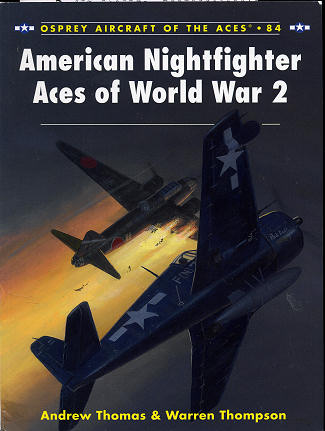 One
rarely puts together the words 'American' and 'Night Fighter Ace' in the same
sentence. That is mostly reserved for the Germans, who had to deal with night
bombing by the British for nearly five years. However, fighting at night was a
specialty that had to be learned by all of the fighting powers to some extent or
another. For the British, it was German night raiders and intruders. For the
Americans, it was basically night intruders.
One
rarely puts together the words 'American' and 'Night Fighter Ace' in the same
sentence. That is mostly reserved for the Germans, who had to deal with night
bombing by the British for nearly five years. However, fighting at night was a
specialty that had to be learned by all of the fighting powers to some extent or
another. For the British, it was German night raiders and intruders. For the
Americans, it was basically night intruders.
It will surprise few that many of America's first night
specialists were flying for the RAF or RCAF. These men picked up their skills in
Beaufighters and Mosquitos for the most part. Some were quite successful at it,
though no American was able to rack up the scores of his German counterpart. In
fact, it seems that 7 was about it. Some of these men helped to train the first
US night fighter units in Europe who, understandably, flew Beaufighters or
Mosquitos as there was little initially available. Later, when the P-61 became
operational in Europe just after D-day, that was the main aircraft of choice.
Yet still, the Army Air Force's top ace (and there were only five) was only able
to claim seven victims.
In the Pacific, things were about the same, though there was
no ready supply of experienced pilots. Most of the night kills were by USN and
USMC pilots. These men were mostly flying from land bases and most of their
victims were Japanese Betty bombers who were flying night intruder or recce
missions. The USAAF had but one Pacific night fighting ace and he was flying a
P-61. The Navy and Marine aces were generally flying Hellcats, though some
pilots had success with the Corsair.
This book covers the full spectrum of US night fighting
including the men and aircraft that they flew. In addition to the nice selection
of period photographs, there is a substantial color profile section in the
center of the book that depict many of the different aircraft types used during
the war.
It is a fascinating look into an area that was at one time a
specialty, but is now, thanks to technology, something that all fighter pilots
have to learn. It is a book that I know you'll enjoy reading and one that will
make a great addition to your library.
October 2008
For more on the complete line of Osprey books,
visit www.ospreypublishing.com. In the US, it is
Osprey Direct at 44-02 23rd St, Suite 219, Long Island City, NY 11101., where you can
get a catalogue of available books.
If you would like your product reviewed fairly and quickly, please contact
me or see other details in the Note to
Contributors.
 One
rarely puts together the words 'American' and 'Night Fighter Ace' in the same
sentence. That is mostly reserved for the Germans, who had to deal with night
bombing by the British for nearly five years. However, fighting at night was a
specialty that had to be learned by all of the fighting powers to some extent or
another. For the British, it was German night raiders and intruders. For the
Americans, it was basically night intruders.
One
rarely puts together the words 'American' and 'Night Fighter Ace' in the same
sentence. That is mostly reserved for the Germans, who had to deal with night
bombing by the British for nearly five years. However, fighting at night was a
specialty that had to be learned by all of the fighting powers to some extent or
another. For the British, it was German night raiders and intruders. For the
Americans, it was basically night intruders.